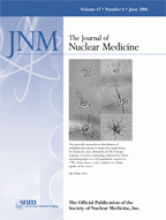Mothersill and Seymour look at the promise of targeted radiotherapy and the evolving meaning and understanding of “bystander effects” as reported in an original article in this issue.
Page 899
Larson and Schwartz preview an article in this issue on the use of 18F-FDG PET in clinical trials and address the growing potential for PET as a biomarker to assess treatment response.
Page 901
Chen and colleagues compare the abilities of 18F-FDOPA and 18F-FDG as PET tracers in the assessment of amino acid and glucose metabolism in primary, recurrent, and metastatic brain tumors.
Page 904
Reardon and colleagues report on the dosimetry, pharmocokinetics, toxicity, and antitumor activity of a human IgG2/mouse chimeric monoclonal antibody administered directly into the surgical resection cavity in patients with malignant glioma.
Page 912

Catafau and colleagues describe quantification methods for a novel 123I-labeled SPECT ligand for the 5HT2A receptor and discuss the utility of the resulting simple protocol, which avoids arterial blood sampling and serial scanning over time.
Page 919
Catafau and colleagues expand on the study reported in the previous article, assessing the specificity of tracer-to-receptor binding, the relationship between ketanserin plasma concentrations and tracer displacement, and the suitability of the cerebellum as a reference region for quantification.
Page 929

Picchio and colleagues compare the diagnostic accuracies of contrast-enhanced CT and 11C-choline PET for staging of urothelial bladder cancer, with special attention to ability to pinpoint lymph node metastases.
Page 938
de Geus-Oei and colleagues report on the use of noninvasive image-derived input functions as an accurate, simple, and clinically viable alternative to arterial blood sampling in 18F-FDG PET evaluation of chemotherapeutic response.
Page 945
Jacene and colleagues evaluate the effects of pegfilgrastim, a long-acting granulocyte colony–stimulating factor, on biodistribution of 18F-FDG in a rat model and in patients with breast cancer and discuss the significance for 18F-FDG PET evaluation of tumor response.
Page 950
Belhocine and colleagues provide a comprehensive educational review and literature survey on the role of nuclear medicine techniques in the detection, staging, and restaging of malignant melanoma.
Page 957
Reinartz and colleagues describe the development of a procedure designed to automatically analyze ventilation/perfusion lung scans for match and mismatch defects, an approach that would improve SPECT accuracy and efficiency in identifying pulmonary embolisms.
Page 968
Kreissl and colleagues noninvasively determine parameters of cardiovascular function in mice by high-temporal-resolution imaging with a dedicated small-animal PET system, a technique with promise for monitoring change in response to pharmacologic intervention.…Page 974

Askoxylakis and colleagues conduct binding and biodistribution studies in mice to assess the potential of a 125I-labeled peptide as a candidate for the development of a neuroblastoma-specific vector to be used for drug targeting or radiopeptide-based diagnosis and therapy.
Page 981
Yuan and colleagues evaluate the recently developed tracer 64Cu-ATSM as a hypoxia PET marker in a rat model and compare the results with those from a well-established hypoxia marker.
Page 989
Fueger and colleagues report on the effects of variations in dietary conditions, mode of anesthesia, and ambient temperature on the biodistribution of 18F-FDG in mice undergoing small-animal PET imaging.
Page 999
Boyd and colleagues investigate the significance of indirect effects in targeted radionuclide treatment by performing a comparative assessment of biologic bystander effects resulting from external beam γ-radiation and those resulting from exposure to 3 radiohaloanalogs of MIBG.
Page 1007

Iozzo and colleagues determine in a swine model whether 18F-FDG can be used in simultaneous estimation of whole-body glucose turnover and production during the fasting and hyperinsulinemic states, facilitating correlation of systemic glucose metabolism with regional 18F-FDG PET.
Page 1016

Reilly and colleagues evaluate the pharmacokinetics, tissue distribution, radiation dosimetry, and toxicology of human epidermal growth factor and 111In-DTPA in mice and rabbits and discuss the implications for radiotherapeutic applications in growth factor receptor–positive breast cancer.
Page 1023
Lipowska and colleagues report on mouse and human biodistribution studies of a novel 99mTc-labeled tricarbonyl complex and outline its potential advantages as a clinical renal radiopharmaceutical.
Page 1032

Rowland and colleagues use small-animal PET imaging to assess the characteristics and PET radiotracer potential of 2 new 76Br-radiolabeled compounds with high affinity and selectivity for the σ2-receptor.
Page 1041

Neti and Howell determine the distribution of radiopharmaceutical activity per cell in a cell population and discuss the implications of log normal distribution of cellular radioactivity for predicting biologic response.
Page 1049
Shankar and colleagues present consensus guidelines for the acquisition and analysis of 18F-FDG PET scans of patients participating in NCI-sponsored diagnostic and therapeutic clinical trials.
Page 1059
ON THE COVER
From left to right and top to bottom, these images show cells with 0, 1, 3, 5, 7, and more than 9 α-particle tracks. The number of tracks in a given cell is directly proportional to the cumulated activity, which, in turn, is directly proportional to cellular activity. Therefore, the distribution of tracks per cell can also be used to describe the distribution of activity per cell. Theoretic calculations have indicated that a log normal distribution of radioactivity, as was found within this cell population, can profoundly affect modeling of the biologic response of the population.

SEE PAGE 1052







